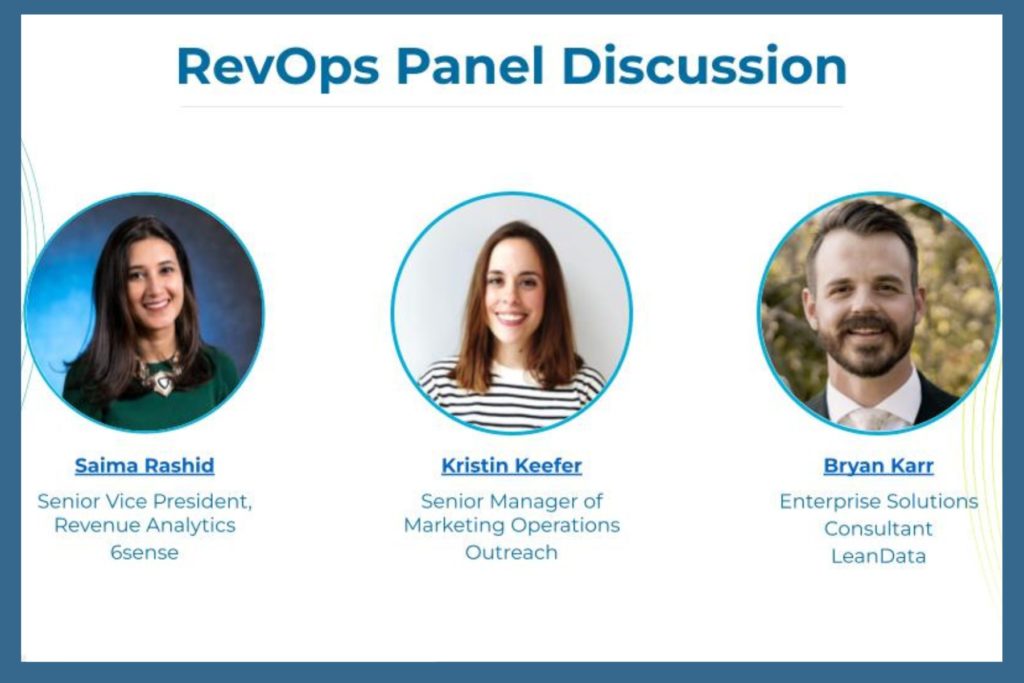Every go-to-market strategy has its achilles heel and breakdowns in account-based motions are no exception.
So when a lead comes in, it’s in the seller’s best interest to take that marketing moment and turn it into some kind of sales outcome.
It sounds so easy: Get the right accounts and contacts to the right Sales rep at the right time. But unfortunately, there are a number of breakdowns in that process, causing teams to spend more time troubleshooting than selling.
In a recent LeanData webinar, three RevOps pros discussed the five most common breakdowns in account-based motions and more importantly, how to fix them.
Breakdown #1 Prioritization & Focus
Today’s digital buyers prefer to remain anonymous while they research your product. In fact, 83% of the buying journey is happening before people even engage with a vendor. To add further complexity, you’re often not selling to one person. Your buyer is actually a fragmented team of buyers across several departments.
As a result, sellers have poor visibility into account details and buyer intent. Without those insights, sellers waste time and attention on leads who either aren’t ready to buy or have no power to make buying decisions for their company.
The Fix for Weak Prioritization
While some companies task their Sales team with manually researching leads, it’s an expensive use of employees meant to be selling, not researching. Luckily, there are several tech tools that can help companies know which buyers should take priority.
First, intent data tools like 6sense uncover known and anonymous buying signals. This includes every account that visits your website, visits your competitors’ websites, or engages with your marketing platform in some way. Intent data platforms can predict where a particular account is in their buying journey and notify your Sales team when to step into the process.
Saima Rashid, Senior VP of Revenue Analytics at 6sense says, “The beauty is, your most expensive resource, which is your Sales team, now spends their time on the accounts that really matter. And, you’re doing it based on what the data and signals are saying.”
Breakdown #2 Complex Sales Teams
Other common breakdowns in account-based motions occur in the distribution of leads within complex sales teams. Large sales teams inherently have challenges with territories and multiple team layers (SDR, BDR, AE, etc.). The management of routine changes to lead routing logic impacts account-based motions.
Sales teams are in constant flux. Companies may develop new territory structures, offer a new product, promote employees, or assign new hires. Companies need to be strategic when identifying which Sales person or team is the best fit for a lead and how leads will be distributed.
While it’s not uncommon to manage territories on a spreadsheet or create custom lead routing rules in a CRM like Salesforce, these processes often become problematic as companies scale. Inefficient or inconsistent lead distribution causes poor response times, lead leakage, constant troubleshooting and ultimately a bad buying experience.
The Fix for Complex Sales Teams
The answer to lead distribution for complex global teams is a dependable lead routing solution that doesn’t rely on manual triage or brittle code. A solid lead routing platform offers features like territory management and round robin pools. It should integrate with other tools in your revenue tech stack to allow for data enrichment and lead qualification. In addition, lead routing changes should be easy to make and flexible to the daily dynamics of a large Sales team.
A lead routing solution should also include automated notifications, preferably through Slack or Microsoft Teams so that Sales team members are alerted when important account-related events occur. A good lead routing solution not only creates a fair and equitable distribution of leads, but more importantly ensures rapid speed to lead.
For example, using LeanData, Trifacta routes leads to SDRs, corporate account executives and partner accounts. Lead response time takes less than 24 hours. With LeanData’s routing flows, Remind, a popular education-sector communication platform, has improved its time to first Sales touch from three or four days to one or two hours.
Zendesk, another LeanData customer, decreased manual lead assignment by 45% and saved approximately 55 hours of work per week, automatically routing an average of 4,100 leads weekly.
Breakdown #3 Missed Opportunities
Once a buyer engages with a company, a company’s response is a huge factor in conversion and ultimately closed deals. However, without tools to form a complete picture of the buying team or a strategy to create further engagement, breakdowns in account-based motions arise Interested buyers often become missed opportunities.
When prospective buyers raise their hands for more information, many companies don’t know the next best step to take. As a result, every buyer receives the same generic response. This looks like relentless phone calls from an SDR and a series of spammy emails that don’t address the buyer’s unique use case. Now, because of a poor buying experience, the once-interested buyer avoids that company altogether.
The Fix for Missed Opportunities
One of the first steps in automating a customized buying journey is lead to account (L2A) matching. This tech tool will reveal if a buyer is a new or an existing customer, screen for your ideal customer profile (ICP) fit, and identify the buyer’s role and product interest. L2A matching brings context to the lead. Another benefit of L2A matching is that it prevents misaligned account data from junking up your CRM with duplicates or dirty data. L2A matching saves time spent researching, troubleshooting, and pursuing unqualified leads.
With L2A matching in place, the next step is to send the right message to the prospective buyer. For this play, there are several account-based motions, easily automated, that will create a customized buyer experience.
Sales engagement platforms (SEP) like Outreach, Salesloft, and others, when integrated with LeanData, will route a prospective buyer to the right rep with the appropriate context. This immediately queues the lead for automated engagement catered to their persona and buying stage.
Kristin Keefer, Senior Manager of Marketing Operations at Outreach, leverages LeanData, 6sense, and Outreach to execute ABM plays. Not only does Outreach assign hot accounts to their sales reps, but they also provide contextual insights and triggered engagement sequences, all in a timely manner.
“From intent signal to outbound execution is happening in one workflow. We are marrying three different tools that otherwise would be disjointed and cumbersome for our Operations team,” says Keefer.
Breakdown #4 Legacy Processes
It’s not uncommon for a company’s IT department to be assigned the role of lead routing changes. While the Marketing and Sales teams usually determine strategy, the IT department is often tasked with building and modifying code to make the routing happen. Unfortunately, involving the IT department in change management can create a delay which negatively impacts speed to lead. And when speed to lead is lacking, customers quickly lose interest.
For example, LeanData customer Dell’s 10+ year Salesforce instance was weighed down with technical debt and over-customization. When a change in logic was needed, Marketing Ops team members had to work with IT to request the change. And with routing logic going through IT, individual changes would be implemented without being fielded by related departments to ensure it complied with global processes and best practices. As a result, leads were taking much longer to get to the Sales Team.
The Fix for Legacy Processes
ABM motions need constant testing and iterative improvements. So, one of the best ways to solve the delays and inefficiencies created by legacy processes is to hand over the reins to a RevOps or Marketing Ops (MOps) department. This removes the IT middleman. Then, changes in Sales team members, territories, lead routing and campaign messaging can be made immediately.
If your RevOps or MOps team members are not trained in Apex code, custom flows or Salesforce lead assignment rules, consider switching to a no-code platform.

Breakdown #5 Accountability
Lead response time requires accountability. A Xant (now InsideSales.com) Lead Response Report revealed that if a company attempts contact within five minutes after a lead submission, the odds of making contact are 100 times greater than if that same lead is contacted 30 minutes after submission.
The majority of buyers are now deep into the Consideration phase of their buying journeys before they ever engage with a seller. So, once a buyer makes contact, the clock is ticking. Buyers will look elsewhere if your lead response time is too long.
There are all kinds of statistics proving that the faster you respond to a lead, the more likely you will convert them into a paying customer. Unfortunately, many B2B companies have no framework to hold their Sales teams accountable for response time and follow up.
The Fix for a Lack of Accountability
One method to enforce accountability with your Sales teams is to establish Service Level Agreements (SLAs). Most powerful when automated, SLA require a respond to leads within a certain time period. SLAs can also prevent unnecessary disagreements and finger-pointing within your team.
For example, Cybrary uses LeanData to route leads and automatically places them into a round robin pool for SDRs. Cybrary SDRs receive an instant Slack notification when a lead has been routed to them. Cybrary’s Sales leadership also receives a notification every time a lead is rerouted in LeanData, adding another layer of accountability.
For hot leads, which include demo requests or business trials, the Cybrary SDRs have 20 minutes to contact the lead. If they aren’t able to do so within that time frame, LeanData automatically reroutes the lead to another SDR. This enables Cybrary to reach out to leads faster and drive conversions.
Tackle Breakdowns in Account-Based Motions Like a Pro
Every company wants to grow their sales pipeline, but consistent revenue comes from growth in valuable pipeline. Selling into a large and complex buying committee needs a seamless and coordinated approach. The right tools in your tech stack, working together, will drive alignment between Sales and Marketing, eliminate breakdowns in account-based motions and create a repeatable playbook of success.















